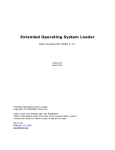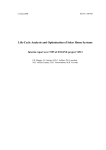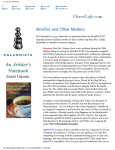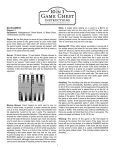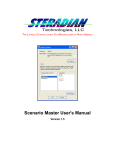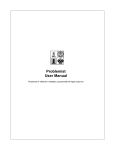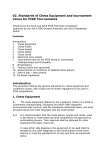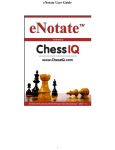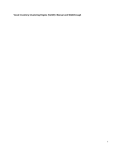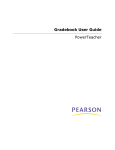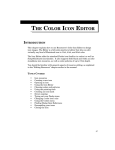Download An Arbiter`s Notebook
Transcript
Must a Touched Piece Always be Moved? Question Dear Mr. Gijssen, I would like to ask two questions about the Handbook. Both of them refer to item C.06. in the FIDE Tournament Rules in the Annex to the FIDE Tournament Regulations, specifically regarding tiebreaks. Purchases from our chess shop help keep ChessCafe.com freely accessible: Question One Subsections (d) and (g) both state, The greater number of games played with the black pieces. Is this an editorial error? An Arbiter’s Notebook Geurt Gijssen Translate this page Perhaps this refers to, in at least one case, "more games won with black pieces" and/or "the best result with black pieces" (win + draw)." Could you please clarify these points? Question Two (b1) The Koya System extended. The Koya System may be extended step by step to include score groups with less than 50 %, or reduced step by step to exclude players who scored 50% and then higher scores. 888 Miniature Studies by Genrikh Kasparian As this may be interpreted in different ways, does FIDE advise to follow a specific criterion to start tie-break; for example, "To start with the first score group," or is the criterion to be chosen at the principal arbiter's discretion? Thanks in advance for your kind attention. Yours sincerely, FA Javier U. Gilmet (Uruguay) Answer One You are right. (g) should be the "greater number of games won with the black pieces." Answer Two I want to make it very clear that the (chief) arbiter is not responsible for the regulations used in a tournament, this is the responsibility of the organizer. Second, FIDE, provided it is not the organizer of an event, does not give advice regarding the application of any tiebreak system. Thus, the organizer decides which tiebreak system will be applied, but the organizer may ask for advice from anyone he wishes, including the (chief) arbiter. Moreover, all criteria to be applied in a tournament must be part of the regulations of the tournament and communicated with the players in a timely fashion. The regulations of the tournament must be sent to the players with the invitation. Chess Informant 110 by Chess Informant Question Dear Mr. Gijssen, I would like to know your opinion about the following episode. I was deputy arbiter in the sixteenth world senior championship 2006 played in Arvier (Aosta Valley-Italy). A game of the third round reached the diagram position: Gligoric's Music CD by Svetozar Gligoric [FEN "5r1k/1p4b1/p5p1/2Prn2p/1P4q1/ 4Q1B1/P4P2/2RR1K2 w - - 0 33"] Black's last move was 32…Rd8xBd5. After White's move, Black summoned me and told me that White had played first 33.Rc1xd5, but soon after he tried to correct his mistake playing 33. Rd1xd5. According to his claim, Black asked me to enforce the regulation. First of all, I asked which piece White touched first. Both players agreed that White touched first the Rc1. I decided not to compel White to move the Rc1, but I let him play 33.Rd1xd5. My decision derived from the following reasoning: ● ● ● The thirty-third move was a capture, else White had to move the Rc1. It is evident that White intended to capture the black rook with his Rd1 and not to move the Rc1. I convinced myself that White touched the Rc1 not "deliberately" (according to article 4.3 of the Laws of Chess), but only as a slip of hand (lapsus manus). Note that the two white rooks are very close. Was I wrong? I showed the case to many people (arbiters and players) and more than eighty percent said I was wrong. Now I still have doubts. For this reason your judgment will be very important for me. Thank you very much. Renzo Renier (Italy) Answer I refer to Article 4.3 of the Laws of Chess: If the player having the move deliberately touches on the chessboard: a. one or more of his own pieces, he must move the first piece touched which can be moved. b. one or more of his opponent's pieces, he must capture the first piece touched which can be captured. c. one piece of each colour, he must capture the opponent's piece with his piece or, if this is illegal, move or capture the first piece touched which can be moved or captured. If it is unclear, whether the player's own piece or his opponent's was touched first, the player's own piece shall be considered to have been touched before his opponent's. The question is, of course, did the player in your case deliberately touch the rook on c1? My personal opinion is that he did not. Therefore, I agree with your decision and surrounding argument. Question Dear Geurt, a player secures an Elo of 2300 very quickly in a tournament, qualifying him for a title. Does he get the title immediately, or must he wait until the tournament finishes? Thanks, Wilfredo Paulino (Dominican Republic) Answer You mention that a player secured a rating of 2300. This means you refer to the title of FIDE Master. In the title regulations I found the following: Title applications based on unpublished ratings shall only be accepted by FIDE after agreement with the Rating Administrator and the Chairman of the Qualification Commission. Ratings in the middle of a period can be confirmed only after all tournaments for that period have been received and rated by FIDE. I spoke with the chairman of the Qualification Commission of FIDE. He confirmed that all titles are awarded at the end of a rating period. Question Dear Mr. Gijssen, from time to time I meet players who move pieces and pawns very lazily, leaving part of the base between the squares rather than placing the piece or pawn in the center of the intended square. As you have to keep adjusting the opponents pieces, it takes your mind off of the game and you can lose patience with opponents who persistently place their pieces incorrectly. Personally, I consider this to be a form of gamesmanship and not within the spirit of the game. Is there a rule that states a player when making a move, should place a piece or pawn within the intended square on the board? If such a rule exists, what is the penalty for not placing the pieces within the intended squares? Kind regards, John Smudger (UK) Answer You are right. There is no article in the Laws of Chess that describes how to place the pieces on the squares. Nevertheless, the player may inform the arbiter that the behavior of his opponent is annoying. I am sure when the player shows him how the opponent is placing the pieces on their square, the arbiter will take measures. I refer to Articles 12.6 and 12.7: It is forbidden to distract or annoy the opponent in any manner whatsoever. This includes unreasonable claims, unreasonable offers of a draw or the introduction of a source of noise into the playing area. Infraction of any part of Articles 12.1 to 12.6 shall lead to penalties in accordance with Article 13.4. Question Hi Geurt, I have some questions. Question One White has king and bishop; Black has king, queen, and rook. Black's flag falls. Is it a draw, because White is not able to checkmate the black king? Suppose, Black has in addition a pawn. Is this won for White after Black's flag has fallen? I think "yes," because Black can blunder his queen and rook and promote his pawn to a knight. In this case it is possible to checkmate the black king. Is this rule applicable for all types of chess? Question Two Suppose that in the situations mentioned in the first question, White has only two seconds left at the moment Black's flag has fallen. Then it is debatable whether White is still able to checkmate Black's king within these two seconds. Does it make any difference how much time White has left? Question Three A player plays one of his pawns to the last rank, presses his clock, and replaces the pawn by any piece of the same color. Does he lose the game because the move is illegal? Question Four A game is played with a digital chess clock. Both displays show 0.00, but in one of the displays a flag is shown, indicating which flag has fallen first. Is it a draw? Question Five A player attacks the opponent's king with his king, but the opponent does not notice it. Can the player claim a win? Question Six I found the following list made by Mr. Sahasrabudbe, appearing in your July 2002 column. White's flag has fallen. Is this list still applicable? White 1. 2. 3. 4. 5. 6. 7. 8. K + any force K + opp. col. B/N/P K + Q/R/same col. B K + opp.col.B/N/P + any/all other e.g. K + Q + N K + R/B/N/P K+Q K + R/B/N/P + any/all other force e.g. K + Q + N K + any force Black 1. 2. 3. 4. 5. Lone K K+B K+B K+B K+N 6. K +N 7. K + N 8. K +Q/R/2B/B+N/P/2N Result 1. 2. 3. 4. 5. 6. 7. 8. ½-½ 0-1 ½-½ 0-1 0-1 0-1 0-1 0-1 Best regards, Peter Verbeeren (Belgium) Answer One The answer is yes in all cases. Answer Two In my opinion it doesn't matter how much time is left. Only the position is relevant. Answer Three I refer to the first sentence of Article 7.4.a of the Laws of Chess: If during a game it is found that an illegal move, including failing to meet the requirements of the promotion of a pawn or capturing the opponent's king, has been completed, the position immediately before the irregularity shall be reinstated. As you can see, the player makes an illegal move. It does not matter that he replaced the pawn after he had pressed his clock. And completing an illegal move has different penalties: ● ● ● In normal games: the opponent receives two extra minutes and the third illegal move has as consequence that the offending player even loses the game. In Blitz and Rapid games with adequate supervision the same happens as in normal games. In Rapid games and Blitz games with inadequate supervision, the arbiter shall intervene, if possible. If the arbiter declares the game lost for a player, then the opponent must have sufficient material to checkmate the player by a series of legal moves. If such a checkmate is impossible, the arbiter declares the game drawn. Answer Four If it is clear which flag has fallen first, then the game should be declared lost for the player who overstepped the time limit. This is a general rule. But in case the opponent cannot win by any series of legal moves, the game is drawn. There is another exception. If both flag have fallen in a Rapid or Blitz game and there is no adequate supervision, the game is also a draw. Answer Five Refer back to the third answer. Answer Six As I stated in 2002, the sixth case of king and queen versus king and knight is a draw. Also a draw is king and bishop vs. king and bishop with bishops on the same color squares. As a reader once also pointed out, even if we increase the number of bishops on the same color squares, it is still a draw. Question Dear Mr. Gijssen, when counting Buchholz in the case of an absence of one of the opponents there are two recommendations: 1. Handling of unplayed games For tie-break purposes, the result shall be counted as a draw against the player himself. (Annex to the FIDE Tournament Regulations regarding tiebreaks) 2. Handling of unplayed games for calculation of Buchholz (Congress 2009) There are two points of view for the player himself who gets a result by default or is absent. A virtual opponent of the player is used to calculate the Buchholz of the player. A virtual opponent has the same points at the beginning of the round and the result by default of a player is treated as a normal result, so a loss by default (or absence) is a win for the virtual opponent and vice versa. For each next round the virtual opponent gains half a point. For the opponents in other rounds of the player who gets a result by default: For reducing the consequence for the opponents when calculating Buchholz, each result by default of a player is counted as a half point (draw) for the Buchholz of the player's opponents (FIDE Swiss Rules). 1. Are these both FIDE recommendations equivalent? 2. If one of these recommendations has priority, which one and since when? 3. If neither during the tournament opening procedure, nor in tournament regulations the chief arbiter has announced which of the recommendations will be used with the computer program Swiss Master 5.1, does it imply that final standings calculated by this program will be considered per default? 4. Given that drawing in a Swiss tournament is made by Swiss Master 5.1, how shall the chief arbiter rule upon the player's appeal against calculating Buchholz by this program per default, if for him "draw against virtual opponent" is favorable? Neither during the opening procedure nor in tournament regulations there has been any mention of the method applied. Swiss Master 5.1 calculates Buchholz as "draw against the player himself." Best regards, Yauheni Kakhno (Russia) Answer It was an oversight by all concerned that both systems (draw against the player himself and applying a virtual opponent) were published in the FIDE Handbook. It was simply a mistake. Furthermore, I am not sure that all programmers of the Dutch program have included the system of the virtual opponent in their Swiss programs. Regarding Swiss Master the Dutch Chess federation informed me that Swiss Master 5.5 (build 15) still applies the system "draw against the player himself." It is possible to download from the website of the Dutch Chess Federation an executable that offers the system "of the virtual opponent." This produces automatically Swiss Master 5.5 (build 18). It means Swiss Master 5.5 (build 15) produces only the calculations using the system "draw against the player himself," whereas Swiss Master 5.5 (build 18) produces the calculation of unplayed games in Sonneborn –Berger and Buchholz applying the system of the virtual opponent. There is a proposal for the Executive Board in October 2011 to choose the system that will be applicable in the very near future. The intention is to use the system of the virtual opponent. As already mentioned, I am not sure that all programs apply the system of the virtual opponent. I suggest that, if an organizer does not state in advance which system applies, the default system should be the system of the draw against the player himself. I will keep you informed. Question One Dear Sir, recently I saw a problem in a tournament (I didn't arbitrate); the arbiters had many doubts about the decision. Player A plays a move which checks Player B's king, but Player B didn't see that check and he checks Player A's king (illegal move). At that moment Player B saw Player A's flag has fallen. According to my view, the illegal move stands because we can revise the game to a correct position and add two minutes to Player A's time. One can argue that according to flag fall Player A lost the game but if we count the illegal move Player A receives an extra two minutes, which changes the whole game. Question Two Article 6.11 of the Laws of Chess says: If both flags have fallen and it is impossible to establish which flag fell first then a. the game shall continue if it happens in any period of the game except the last period. b. the game is drawn in case it happens in the period of a game, in which all remaining moves must be completed. Sir, what does this phrase "last period," as well as the phrase, "in which all remaining moves must be completed," mean? I don't have a clear understanding of these, and if you can give me a simple definition for this 6.11, I will be most grateful. Regards, Malith Akalanka (Sri Lanka) Answer One I refer to Article 5.1 of the Laws of Chess: The game is won by the player who has checkmated his opponent's king. This immediately ends the game, provided that the move producing the checkmate position was a legal move. I agree that this article does not cover the case you mentioned, but it is comparable. The game appears finished with the overstepping of the time control, but in case an illegal move was completed before the flag fall, it is not unreasonable to follow the same procedure. Answer Two Games can be played with different time controls. I give three examples: 1. A time control of forty moves in two hours, followed by one hour for the remaining moves. 2. The time control can also be forty moves in 100 minutes, then twenty moves in fifty minutes and finally fifteen minutes for the remaining moves with an increment of thirty seconds from the first move. 3. The time control can be that all moves must be played with a time control of two hours for each player. This first example contains two periods of play, the second three, and in the third example, there is only one period of play. In these examples it is possible that at the end of each period both flags have fallen. This article deals with the assumption that it is unclear which one fell first. If it happened at the end of the first period in the first example, the game continues. The same is the case at the end of the first and second period of the second example. But(!), if it happens that both flags have fallen and it is known which one was first, the situation is different. As you can see we then have the case that in a period that all remaining moves must be played in that period. In this case the game will be declared drawn. Your problem was probably that it is clear which period is the last one in the first and second examples, but in the third example the "first" period is also the last one. Question Dear Geurt, I have a question for your column regarding Rapid play. Recently, in a tournament with a time control of game in fifteen minutes, my opponent made a move with his rook and dropped the piece but didn't hit the clock. Then he took the rook again and moved it to a different square. The original rook move was perfectly legal and a huge blunder. I called the arbiter and he ruled that since he hadn't hit the clock he could move the rook to wherever he wanted as long as it was legally possible. Was his decision correct? Which articles apply to this situation? Yours sincerely, Rafael Montero (Spain) Answer I refer to the first sentence of Article 4.6: When, as a legal move or part of a legal move, a piece has been released on a square, it cannot be moved to another square on this move. The move is then considered to have been made. This article states clearly that a legal move has been made at the moment the player has released the played piece on a square. The move cannot be changed. Essential is the release of a piece on a square and not that the clock was pressed. Question Dear Mr. Gijssen, FIDE has recognized the Monroi device for recording chess games. The user manual mentions replay buttons on the bottom of the screen, so it seems you can backtrack earlier played moves and previous positions in the game. In my opinion this is not in accordance with the FIDE laws of the game. With the device you can spot threefold repetition of position. The diagram is visible and helps you to identify the identical positions. What is your opinion in this matter? Regards, Paul-Peter Theulings (Netherlands) Answer As far as I know it is possible to turn off this function. This means there is no problem on the point you mentioned in your question. Question Dear Mr. Gijssen, I have the following situation. In a youth championship, an arbiter is suddenly interested in checking Player A's scoresheet and realizes that the scoresheet is missing some moves. So the arbiter begins to verify the moves on the board, using Player A's time. Then he continues verifying on another table where the clock had already been stopped. After that, the arbiter discovers that Player A's scoresheet is missing two moves. So he makes Player A rewrite the scoresheet; however, now she has only four minutes on the clock instead of ten minutes and forty-five seconds as when the problem began. Player A was three pawns up but hurried, made some mistakes, and finally lost. Was it correct to have the arbiter intervene without a request by Player A? Must she rewrite the scoresheet? Thank you for your answer. Robert Cuadros (Peru) Answer It is very important to me that you mention it happened in a youth tournament. I have stated quite often that an arbiter in a youth tournament has also to act as a teacher and has to take into account the lack of experience of these children. If players (in general) do not record some moves, there is, for me, no need to rewrite the whole scoresheet. What is easier than to compare the two scoresheets and to find out which moves are missing? To answer your main question, it is correct to intervene if something is amiss. Thus, I have no problem that the arbiter intervened, but to force a player to rewrite the whole scoresheet goes too far in my opinion. Question Sir, I am from India, and have a problem that is common to youth tournaments. We know that any player touching a piece must move that piece only, if it is not an illegal move. My question is how do we know and prove that a player touched the piece, when the one player claims that the opponent touched the piece but the opponent says he did not touch it? When I oversaw some tournaments as an arbiter, I gave decisions by inquiring surrounding players and also according to the positions on the board. Were my actions and decisions correct? Please guide me in this regard. Akalamkam Ramakrishna (India) Answer If an arbiter did not witness what happened, it is almost impossible to make a decision that satisfies both players. If a player claims an illegality committed by his opponent and the opponent denies this illegality, the arbiter's decision can be based only on the facts he observes. If he has not seen that a piece was touched, the piece has not been touched. If a player claims that the opponent accepted a draw offer and the proposal had not been recorded on both scoresheets, or the arbiter did not hear the proposal and the opponent denies this proposal, then there is no proposal. These are some examples. In general, if the arbiter was not a witness and there is no evidence that something happened (by consulting possible witnesses), the arbiter should order the game to continue from the actual position that is on the board. The main topic next month will again be Article 10.2 of the Laws of Chess. © 2011 Geurt Gijssen. All Rights Reserved. Have a question for Geurt Gijssen? Perhaps he will reply in his next ChessCafe.com column. Please include your name and country of residence. Yes, I have a question for Geurt! Comment on this month's column via our Contact Page! Pertinent responses will be posted below daily. [ChessCafe Home Page] [Book Review] [Columnists] [Endgame Study] [The Skittles Room] [ChessCafe Archives] [ChessCafe Links] [Online Bookstore] [About ChessCafe.com] [Contact ChessCafe.com] © 2011 BrainGamz, Inc. All Rights Reserved. "ChessCafe.com®" is a registered trademark of BrainGamz, Inc.









